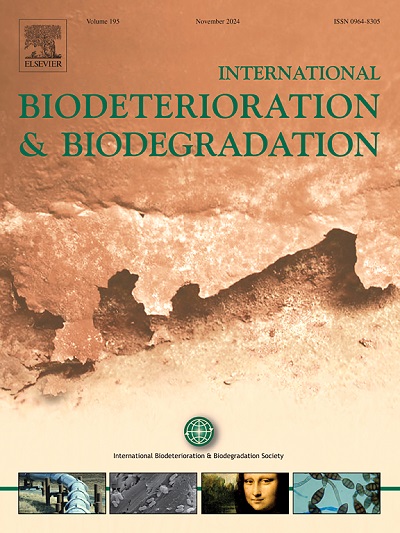Baseline characteristics of the microbial community structure and composition of the world cultural heritage sites in Macau
IF 4.1
2区 环境科学与生态学
Q2 BIOTECHNOLOGY & APPLIED MICROBIOLOGY
International Biodeterioration & Biodegradation
Pub Date : 2025-02-21
DOI:10.1016/j.ibiod.2025.106032
引用次数: 0
Abstract
Microorganisms contribute to the deterioration of materials. In this study, samples were collected from the surfaces of different cultural heritage sites in Macau to reveal the structure and composition of microbial communities and to understand the deterioration mechanisms, which will be helpful in developing strategies to manage and protect these sites. Structure and composition of microbial communities on the surfaces of different types of cultural heritage in Macau, including ceramic-tile walls, architectures in park, and historic buildings, were analyzed by conducting 16S rRNA gene sequencing. Cyanobacteria, Proteobacteria, Actinobacteria, Chloroflexi, Acidobacteria, and Bacteroidetes were found to be most abundant microbial phyla on the surfaces of these cultural heritages of Macau under subtropical conditions. Among them, Cyanobacteria was observed as the dominant microbial phylum, indicating its potential role as a key microbial group responsible for the deterioration of cultural heritages. Significant variations were also observed in the distribution of microbial groups among different surface samples. Shannon index values revealed that microbial communities on the walls of historic buildings were more diverse than those on stones and ceramic tiles. Additionally, the distribution of microorganisms within Macau's cultural heritage sites was intricately linked to temperature, humidity, and climate. The results emphasize the importance of identifying the composition of surface microbial communities for a better understanding of biodeterioration process to protect and manage the cultural heritage sites.
澳门世界文化遗产地微生物群落结构和组成的基线特征
微生物使材料变质。本研究通过对澳门不同文化遗址表面的微生物群落结构和组成进行取样,揭示其退化机制,为文化遗址的管理和保护提供科学依据。通过16S rRNA基因测序,对澳门不同类型文化遗产(包括瓷砖墙、公园建筑和历史建筑)表面的微生物群落结构和组成进行了分析。蓝藻、变形菌、放线菌、绿杆菌、酸杆菌和拟杆菌属是亚热带条件下澳门文化遗产表面最丰富的微生物门类。其中,蓝藻菌被观察到是优势微生物门,表明它可能是导致文化遗产恶化的关键微生物群。不同表面样品的微生物群分布也有显著差异。香农指数表明,历史建筑墙体上的微生物群落比石头和瓷砖上的微生物群落更多样化。此外,澳门文化遗址内微生物的分布与温度、湿度和气候有着复杂的联系。研究结果强调了识别地表微生物群落的组成对于更好地了解生物退化过程对文化遗产保护和管理的重要性。
本文章由计算机程序翻译,如有差异,请以英文原文为准。
求助全文
约1分钟内获得全文
求助全文
来源期刊
CiteScore
9.60
自引率
10.40%
发文量
107
审稿时长
21 days
期刊介绍:
International Biodeterioration and Biodegradation publishes original research papers and reviews on the biological causes of deterioration or degradation.

 求助内容:
求助内容: 应助结果提醒方式:
应助结果提醒方式:


